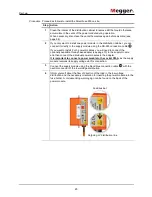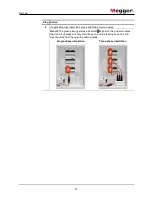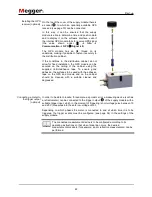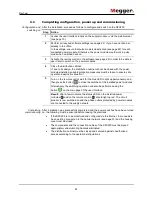
Controlling and monitoring in running operation
43
After activating pulse mode for the phase affected by the fault, the fault can be located
as follows:
Step Action
1
With the surge wave receiver, go to the area in which you suspect the cable
fault is located.
2
Log on with a mobile device on the corresponding SFC250.
If not data connection can be created with the device, the pulse mode can also
be started by a second person in the vicinity of the device (via local
operation,SFC250-RC or WLAN connection).
Press the button
in the main menu or the
button on the remote control
to start pulse mode (
automatic mode
) or trigger a single pulse (
manual
mode
).
Result:
In
automatic mode
, a fault ignition is provoked continuously at the set
interval.
In
manual mode
the button must be pressed again for each additional pulse.
On the LED bar
of the remote control, you can see whether current is
flowing and the fault ignites (see page 35).
3
Locate the exact position of the fault using one of the following methods:
The acoustic and electromagnetic
waves that propagate with each flash-
over can be located using a surge
wave receiver (for example,
digiPHONE
+
).
Repeated closing of the breaker
causes burn-up of the insulation at the
fault location. The resulting gases can
be located with the Fault Sniffer
system.
For information on operation of the surge wave receiver or the Fault
Sniffer system, refer to the associated operating manual.
Fault location in pulse
mode






























